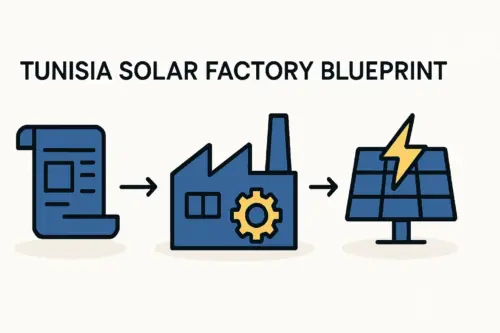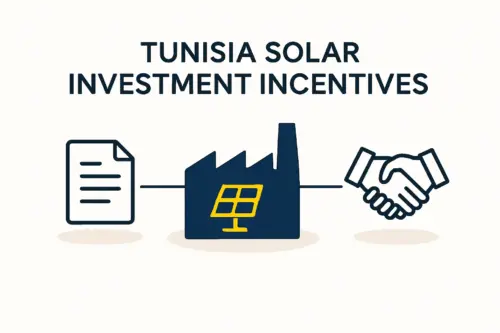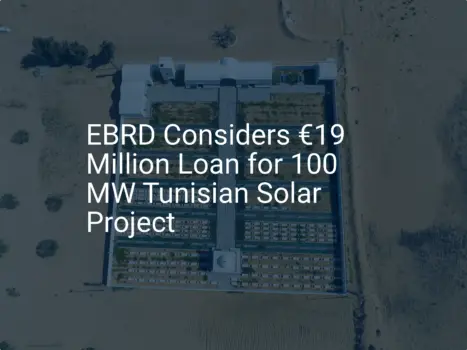A Strategic Framework for Solar Manufacturing in Tunisia: The Public-Private Partnership (PPP) Model
For an investor exploring Tunisia’s energy sector, the nation’s ambitious goal of generating 35% of its electricity from renewables by 2030 presents both a challenge and a significant opportunity. The country’s ‘Plan Solaire Tunisien’ (PST) is driving immense demand for solar photovoltaic (PV) modules, yet with limited local manufacturing, this need is currently met almost entirely by imports.
This gap presents a clear investment case for entrepreneurs who can align their commercial goals with national objectives through a Public-Private Partnership (PPP).
This article outlines a strategic framework for establishing a solar module manufacturing facility in Tunisia through a joint venture between a private investor and a state entity. We will explore the structure of such a PPP agreement, from leveraging sovereign guarantees for financing to navigating the regulatory landscape and developing a market strategy for both domestic and export sales.
Understanding the Tunisian Opportunity: Beyond Sunlight
Tunisia’s commitment to renewable energy is more than an environmental policy—it’s a core pillar of its long-term economic and energy security. For investors, this political will translates directly into tangible market drivers.
-
The ‘Plan Solaire Tunisien’ (PST): This national plan mandates the installation of several gigawatts of solar capacity, which would position a local manufacturing plant as a preferred supplier for large-scale public and private projects.
-
Energy Independence: By localizing the production of solar panels, Tunisia reduces its reliance on imported energy and hardware, strengthening its economic sovereignty. A PPP in this sector is therefore viewed as a project of national strategic importance.
-
Geographic Advantage: Situated at the crossroads of Europe, the Middle East, and Africa, Tunisia offers key logistical advantages. Trade agreements like the Agadir Agreement provide preferential access to key regional markets.

The Public-Private Partnership (PPP) Advantage in Solar Manufacturing
A PPP brings together a private company and a government entity to finance, build, and operate projects that serve the public interest. For Tunisian solar manufacturing, this model offers a powerful way to mitigate risk and accelerate market entry.
The legal basis for such ventures is well-established by Tunisia’s Law No. 2015-49 on Public-Private Partnerships, which provides a clear and transparent framework. The primary advantage lies in the synergy it creates: the private sector contributes efficiency, technology, and capital, while the public partner offers regulatory support, stability, and access to unique financial instruments.
Ready to make big Profits?
The solar Industry is Booming
WE HELP NEWCOMERS to the solar industry start their own solar module production line. Customers can make BIG PROFITS by selling modules and finding investors, without wasting money and time on things they don't need!
Structuring the PPP Agreement: A Blueprint for Success
A successful PPP hinges on clearly defined roles and responsibilities. The joint venture is typically built around three key partners, each contributing unique value.
-
The Private Investor: Provides the majority of the initial capital, commercial management, and entrepreneurial drive. This investor is responsible for the factory’s day-to-day operational efficiency and profitability.
-
The State Entity: Often represented by an institution like the Société Tunisienne de l’Électricité et du Gaz (STEG) or a regional development agency. This partner typically contributes land, facilitates permits and grid connections, and may commit to purchasing a percentage of the factory’s output through an off-take agreement.
-
The Technical Partner: An experienced engineering firm, such as J.v.G. Technology GmbH, that provides the manufacturing expertise. This partner is responsible for factory design, equipment procurement, installation, and staff training, ensuring the facility meets international quality standards.
This structure distributes risk and aligns all parties toward the common goal of running a successful and profitable manufacturing plant.

Securing Project Financing with Sovereign Guarantees
Securing affordable, long-term financing is one of the most significant barriers for industrial projects in emerging markets. A PPP structure directly addresses this challenge. When a state entity is a partner in the joint venture, the project may become eligible for a sovereign guarantee.
A sovereign guarantee—a government promise to assume the debt if the project defaults—dramatically de-risks the investment for international development banks (like the African Development Bank or European Investment Bank) and commercial lenders. This guarantee unlocks more favorable financing terms. Preparing a financial plan for these institutions requires a full understanding of the investment requirements for solar panel manufacturing.
Market Strategy: Serving Domestic Needs and Export Markets
Long-term viability depends on a well-defined market strategy. The Tunisian PPP model supports a dual approach that balances stable domestic demand with high-growth export opportunities.
-
Domestic Market Anchor: The primary market anchor is the guaranteed demand created by the PST. The state partner can facilitate long-term Power Purchase Agreements (PPAs) or supply contracts with STEG and other public entities, ensuring a consistent revenue stream that covers baseline operational costs.
-
Export Market Growth: With a stable domestic foundation, the factory can leverage Tunisia’s logistical strengths to export high-quality, competitively priced solar modules to Europe and neighboring African nations. This requires a robust solar panel manufacturing business plan detailing market entry strategies, certifications, and logistics for each target region.
The Role of the Technical Partner in a PPP
The technical partner is the most critical component of the PPP, especially for investors without a background in photovoltaics. This expert translates the business vision into an operational reality. Their responsibilities go far beyond simply supplying machines.
A qualified technical partner manages the entire engineering process, from initial feasibility studies to final commissioning. They are responsible for delivering a fully operational turnkey solar panel production line, which includes designing the factory layout, selecting and integrating the right equipment, establishing quality control protocols, and training the local workforce to operate the plant efficiently. Experience from J.v.G. turnkey projects in similar markets shows that this integrated approach significantly reduces the learning curve and time-to-market for new entrants.

Comprehensive FAQ for Investors
What is the typical investment for a small-to-medium solar factory in this model?
For a 50–150 MW annual capacity line, the initial capital expenditure typically ranges from $5 million to $15 million. The exact amount depends on the level of automation and technology chosen.
How long does it take to get a factory operational?
With a structured PPP and an experienced technical partner, a realistic timeline from project agreement to the first module produced is 12 to 18 months.
What are the main risks in a Tunisian PPP project?
Potential risks include bureaucratic delays, political shifts, and currency fluctuations. The PPP structure itself, however, is designed to mitigate these. The state partner helps navigate bureaucracy, while the project’s strategic importance provides a degree of insulation from political shifts.
Does the private investor need a technical background in solar?
No. The model is specifically designed for business professionals and entrepreneurs. The technical complexity is managed entirely by the specialist technical partner, allowing the investor to focus on commercial and financial management.
The Public-Private Partnership model offers a structured, de-risked pathway for investors to enter Tunisia’s burgeoning solar manufacturing sector. By aligning an entrepreneur’s financial objectives with the nation’s strategic energy goals, this approach creates a powerful synergy for long-term success.
For those evaluating this opportunity, the next step is a detailed feasibility study and identifying the right public and technical partners to build a resilient, profitable enterprise.






